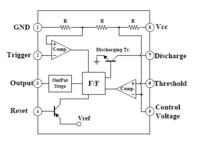boylesg
Advanced Member level 4

- Joined
- Jul 15, 2012
- Messages
- 1,023
- Helped
- 5
- Reputation
- 10
- Reaction score
- 6
- Trophy points
- 1,318
- Location
- Epping, Victoria, Australia
- Activity points
- 11,697
I created a 555 amplifer on my bread board tonight.
Started off with a simple NPN common emitter amplifier witha gain of 10, input impedance of 40r and output impedance of 4k.
This was just enough to get weak audio through a pair of ear buds and very weak audio through an 8r speaked. I measured the impedance of the ear buds at around 32r.
But I took the out put of this and fed it into a stock standard extended duty cycle 555 astable with a frequency of around 30kHz and duty cycle of 50%.
I got a rather powerful audio signal through my 8r speaker, although it is a bit much for the poor old 555 which heats up some what. Can't leave it going for too long.
It is working off 12V. So this bodes well for my musical plasma arc.
I am rather excited at acheiving this.
Still can't get the LM385N based preamplifier working properly. I have the gain adjustable with a 100k pot but I only get a clear signal with the pot at the top of its range. As soon as I adjust the pot the signal becomes very scratchy and staticy. It iwas running it off 24V.
Perhaps 24V is too much for the speakers to work properly and I should try it with 12V and tone down the max gain to 10 or so.
Started off with a simple NPN common emitter amplifier witha gain of 10, input impedance of 40r and output impedance of 4k.
This was just enough to get weak audio through a pair of ear buds and very weak audio through an 8r speaked. I measured the impedance of the ear buds at around 32r.
But I took the out put of this and fed it into a stock standard extended duty cycle 555 astable with a frequency of around 30kHz and duty cycle of 50%.
I got a rather powerful audio signal through my 8r speaker, although it is a bit much for the poor old 555 which heats up some what. Can't leave it going for too long.
It is working off 12V. So this bodes well for my musical plasma arc.
I am rather excited at acheiving this.
Still can't get the LM385N based preamplifier working properly. I have the gain adjustable with a 100k pot but I only get a clear signal with the pot at the top of its range. As soon as I adjust the pot the signal becomes very scratchy and staticy. It iwas running it off 24V.
Perhaps 24V is too much for the speakers to work properly and I should try it with 12V and tone down the max gain to 10 or so.



